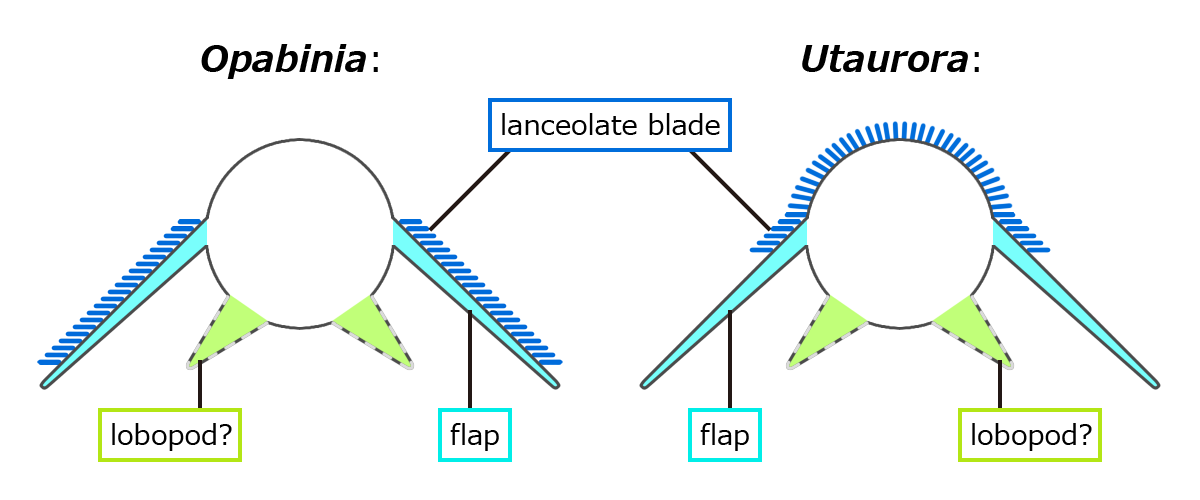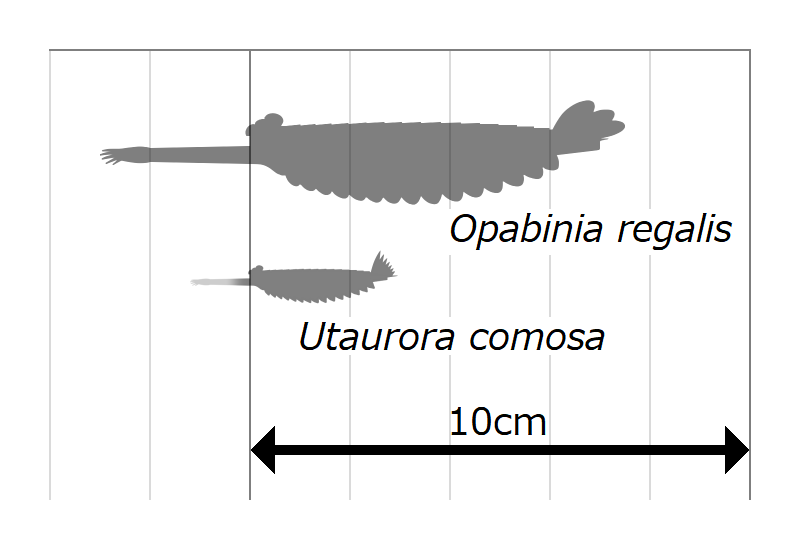Opabiniid on:
[Wikipedia]
[Google]
[Amazon]
Opabiniidae is an extinct 

family
Family (from la, familia) is a group of people related either by consanguinity (by recognized birth) or affinity (by marriage or other relationship). The purpose of the family is to maintain the well-being of its members and of society. Idea ...
of bizarre marine stem- arthropods. Its type and best-known genus
Genus ( plural genera ) is a taxonomic rank used in the biological classification of living and fossil organisms as well as viruses. In the hierarchy of biological classification, genus comes above species and below family. In binomial nom ...
is ''Opabinia
''Opabinia regalis'' is an extinct, stem group arthropod found in the Middle Cambrian Burgess Shale Lagerstätte (505 million years ago) of British Columbia. ''Opabinia'' was a soft-bodied animal, measuring up to 7 cm in body length, and it ...
''. It also contains ''Utaurora
''Utaurora'' is an extinct genus of opabiniid, which were bizarre stem-arthropods closely related to true arthropods and radiodonts; the type species is ''U. comosa''. The animal's fossils come from the Cambrian of Utah. This genus is so far ...
''. Opabiniids closely resemble radiodonts, but their frontal appendages were basally fused into a proboscis
A proboscis () is an elongated appendage from the head of an animal, either a vertebrate or an invertebrate. In invertebrates, the term usually refers to tubular mouthparts used for feeding and sucking. In vertebrates, a proboscis is an elong ...
. Opabiniids also distinguishable from radiodonts by setal blades covering at least part of the body flaps and serrated caudal rami.


History of study
Opabiniidae was named byCharles Doolittle Walcott
Charles Doolittle Walcott (March 31, 1850February 9, 1927) was an American paleontologist, administrator of the Smithsonian Institution from 1907 to 1927, and director of the United States Geological Survey. Wonderful Life (book) by Stephen Jay G ...
in 1912, alongside its type species ''Opabinia''. Walcott interpreted Opabiniidae as a family of anostracan crustaceans
Crustaceans (Crustacea, ) form a large, diverse arthropod taxon which includes such animals as decapods, seed shrimp, branchiopods, fish lice, krill, remipedes, isopods, barnacles, copepods, amphipods and mantis shrimp. The crustacean gro ...
, most closely related to Thamnocephalidae. ''Opabinia'' was restudied in the 1970s, and reinterpreted as a stranger animal. Stephen Jay Gould referred to ''Opabinia'' as a "weird wonder", and an illustration of ''Opabinia'' prompted laughter when it was first revealed at a paleontological conference. In 2022, a second opabiniid, ''Utaurora
''Utaurora'' is an extinct genus of opabiniid, which were bizarre stem-arthropods closely related to true arthropods and radiodonts; the type species is ''U. comosa''. The animal's fossils come from the Cambrian of Utah. This genus is so far ...
'', was identified.
''Myoscolex
''Myoscolex'' is an early animal species known from the Cambrian Emu Bay Shale in South Australia. It was interpreted as an annelid and some supports that theory, while it was also considered as an arthropod close to '' Opabinia'', through other ...
'' from Emu Bay Shale
The Emu Bay Shale is a geological formation in Emu Bay, South Australia, containing a major Konservat-Lagerstätte (fossil beds with soft tissue preservation). It is one of two in the world containing Redlichiidan trilobites. The Emu Bay Shale ...
is sometimes suggested to be an opabiniid, but morphological features supporting this interpretation are controversial. ''Mieridduryn
''Mieridduryn'' is a genus of extinct dinocaridid arthropod that lived during the Middle Ordovician of what is now the United Kingdom. This animal was described in 2022 based on a singular fossil found in Castle Bank, a Burgess shale type lag ...
'' is a panarthropod
Panarthropoda is a proposed animal clade containing the extant phyla Arthropoda, Tardigrada (water bears) and Onychophora (velvet worms). Panarthropods also include extinct marine legged worms known as lobopodians ("Lobopodia"), a paraphylet ...
from the Middle Ordovician
The Ordovician ( ) is a geologic period and system, the second of six periods of the Paleozoic Era. The Ordovician spans 41.6 million years from the end of the Cambrian Period million years ago (Mya) to the start of the Silurian Period Mya.
Th ...
that shares features with both radiodonts and opabiniids.
References
Works cited
* * * {{Lobopodia Prehistoric arthropod families Dinocarida